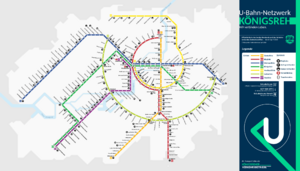Königsreh U-Bahn
This article is incomplete because it is pending further input from participants, or it is a work-in-progress by one author. Please comment on this article's talk page to share your input, comments and questions. Note: To contribute to this article, you may need to seek help from the author(s) of this page. |
 | |||
 U4 at Böcklerstraße station | |||
| Overview | |||
|---|---|---|---|
| Owner | Königsreher Verkehrbetriebe (KRVB) | ||
| Locale | Königsreh | ||
| Transit type | Rapid transit | ||
| Number of lines | 7 | ||
| Number of stations | 219 | ||
| Daily ridership | 1,559,231 (2019) | ||
| Annual ridership | 569.12 million (2019) | ||
| Website | kvb.ubahn.mc | ||
| Operation | |||
| Began operation | 21 May 1919 | ||
| Operator(s) | Königsreher Verkehrsbetriebe (KRVB) | ||
| Technical | |||
| System length | 179.4 km (111.5 mi) | ||
| Track gauge | 1,520 mm (4 ft 11 27⁄32 in) | ||
| Electrification | 806 V DC third rail | ||
| Average speed | 33.85 km/h (21.03 mph) | ||
| |||
The Königsreh U-Bahn is an electric rail rapid transit network in Königsreh, Mascylla's capital and second largest city. Serving as one of the four components of the city's public transport capabilities, along with the S-Bahn, buses and a tram network, it is owned, maintained and operated by the Königsreher Verkehrsbetriebe (KRVB, "Königsreh Transport Company"). It is additionally integrated into the Verkehrsverbund Zentralmaskillien (VZM, "Transport Association of Central Mascylla") to expand its network and allow access to the cities of Flussmund, Lehpold and Lensrau.
The first line, the U1, was finished and opened to the public on 21 May 1919; it is the second-oldest metro line and system currently in operation in Erdara, after the Ulich metro. Today it contains 179.4 kilometres (111.5 miles) of tracks and routes, serving 219 stations on 7 separate lines, making it the largest metro system in Mascylla and fourth largest worldwide. In 2019, around 1.56 million people used the U-Bahn each day, or about half of Königsreh's population, and more than 569 million throughout the year; it is the busiest means of transportation in the city and country respectively and the most expensive public transport system in Erdara.
History
Conceptualization and difficulties
Untergrundbahn and first lines (1919-1939)
Later development and expansions
Außenlinie and U7 expansion
Landherrenallee controversy
Main article: Landherrenallee
Accidents and incidents
Roundel
The logo or roundel of the metro has seen various alterations throughout its history. All versions, excluding the first one utilized from 1919 to 1939 depict a capitalized "U" as the abbreviation of "U-Bahn" and "Untergrund", the Hesurian term for "underground" and "rapid transit" together. The first one to be counted as a logo of the metro is the trademark of the Hauptstadtregion Königsreh Untergrund-Bahn. The colours blue and white were also heavily used to differentiate from the colour schemes of the city's other public transport, most notably the S-Bahn which uses an orange-white palette, the buses green-white, and the trams purple-white, respectively.
Despite its simplistic design, it has risen to the status of a cultural icon of the city and has thus never been completely remodelled. The logo is most frequently used on stations and platform signs to signal the presence of an U-Bahn connection at the location, on the front of U-Bahn trains, or on maps of the system to notify the viewer; it is however mostly used in tandem with the logo of its umbrella company, the Königsreher Verkehrsbetriebe, usually depicted in the lower left or right section of the sign space. There is no formal code as to how the logo is to be used however.
Network
Map
Lines
Currently seven lines are maintained and part of the system:
| Line | Colour | Name | Start terminus | Transfer stations | End terminus | Stations | Opening |
|---|---|---|---|---|---|---|---|
| Orange | Zentrallinie | Schrödernplatz | Hauptbahnhof - Königsdamm - Burggrafenstraße - Klaus-Edger-Straße - Aldischer Platz - Hönigmannstraße - Rathaus Schönhoch - Oberneuenweide | Wildenbruch | 32 | 21 May 1919 | |
| Red | Ringlinie | Schrödernplatz | Westbahnhof - Messaltstraße - Lorenzinsel - Zoologischer Park - Auroraplatz - Ahnerndamm - Fahnichtplatz- Erwin-Reuthers-Platz - Königsdamm - Burggrafenstraße - Klaus-Edger-Straße - Aldischer Platz - Hönigmannstraße - Rathaus Schönhoch - Rommiestraße | Schönkiefer | 36 | 17 November 1925 | |
| Blue | Metropollinie | Am Bergpark | Neckentor - Kaiserin-Anneliese-Straße - Alsenplatz - Jensenmarkt - Friedenau - Westbahnhof - Henckenallee - Lehpolder Platz - Lustgarten - Reichsrat - Kaulsmarkt - Hauptbahnhof - Würthersstraße - Marcowallee | Kaulsberg | 61 | 6 April 1927 | |
| Green | Königslinie | Grätzwalder Allee | Terundertor - Hauptbahnhof - Kaulsmarkt - Reichsrat - Lustgarten - Lehpolder Platz - Henckenallee - Westbahnhof - Friedenau - Jensenmarkt - Alsenplatz - Kaiserin-Anneliese-Straße - Böcklerstraße - Sarah-Kaiser-Damm - Akademie der Wissenschaften - Tyron-Heep-Straße - Piedbalenskistraße - Klöppelheide - Nikolaisheim | Bahnhof Hadernsee | 58 | 14 February 1930 | |
| Yellow | Nordstadtlinie | Henckenallee | Messaltstraße - Lorenzinsel - Zoologischer Park - Auroraplatz - Ahnerndamm - Fahnichtplatz- Erwin-Reuthers-Platz - Königsdamm - Terundertor - Würthersstraße - Flughafen Albert-Polschnitz | Alt-Ahndau | 35 | 10 July 1931 | |
| Lime | Außenlinie | Neckentor | Böcklerstraße - Hensbach - Oberneuenweide - Rommiestraße - Grätzwalder Allee | Marcowallee | 38 | 28 August 1963 | |
| Purple | Flusslinie | Jensenmarkt | Friedenau - Westbahnhof - Hensbach - Sarah-Kaiser-Damm - Akademie der Wissenschaften - Tyron-Heep-Straße - Piedbalenskistraße - Klöppelheide - Nikolaisheim | Bahnhof Hadernsee | 31 | 11 April 1942 |
Stations
Every train station is additionally referred to by a one to four digit long abbreviation used for operational purposes; the abbreviations are used for the exact identification of platform levels, namely for crossing stations. The railway network encompasses 219 stations in total, 6 of which are as of 2020 involved in construction or renovation activities and an additional 4 were closed indefinitely in the past (the stations being Nordhafen, Kusische Straße, Timo-Wittberg-Straße and Sainsfeld). With a total network length of 179.4 km (111.5 mi), the average distance between the station is about 819 metres, while the station platforms are 90 metres in length on average. Apart from a number of exceptions, most stations are built as tunnel stations underground. In most cases, each station is two-pronged with a centrally aligned platform, though that can differ if a station is considerably larger and possesses multiple levels. The majority of stations is accessible through atleast two entry points, and every station contains escalators and lifts, as well as sanitary and consumer services.
All stations of the lines U1, U2 and U7 are small profile stations, while all stations of the lines U3, U4, U5 and U6 are large profile stations. Of the 104 administrative neighborhoods of Königsreh, about 49 are linked to the rapid transit network. Most of the stations are located in the boroughs of Lorenz-Prinzwald (with 29 stations), Köpenick (20 stations) and Fichtau (18 stations), while Bölche, Kronetz and Tülwitz are served by a single station. From the 219 stations, many of which have discrepancies or aesthetic variations, most notably Hensbach with its sacral architecture, Westbahnhof as the largest station with four individual platform levels, and Königsdamm which was merged with a previous station (Soijusstraße), giving it a distinct bipolar aesthetic.








